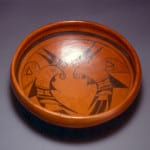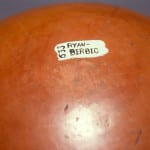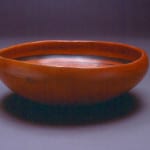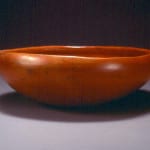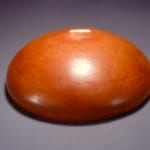Hopi redware bowl, Nampeyo, circa 1915. This is the first Nampeyo bowl in this collection.
The body of this pot is made from yellow “sikyatska” clay that fires red; it is not just sikyatska slipped. Since the yellow clay is difficult to work, this is unusual. The extra rim coil is a trademark of Nampeyo’s bowls (Blairs,1999:91).
This design is a reinterpretation by Nampeyo of a “Man-eagle” design found on a 15th century Sikyatki bowl excavated in 1895 by Jesse Walter. Fewkes (1898: 682-683; also 1973:59.). Of this bowl Fewkes wrote:
“There can be no reasonable doubt that the decoration of ….(this)…food bowl represents a bird, and analogy would indicate that it is the picture of some mythologic personage. It has a round head to which is attached a headdress, which we shall later show is a highly modified feather ornament. On each side of the body from the region of the neck down there are organs which are undoubtedly wings, with feathers contained into arrow points. The details of these wings are carefully and, I may add, prescriptively worked out, so that almost every line, curve or zigzag is important. The tail is composed of three large feathers, which project beyond two triangular extensions, marking the end of the body…
While it is quite apparent that this figure represents a bird, and while this identification is confirmed by Hopi testimony, it is far from a realistic picture of any known bird with which the ancients could have been familiar. It is highly conventionalized and idealized with significant symbolism, which is highly suggestive (1898:682).”
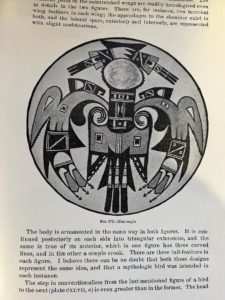
Bowl excavated by Fewkes in 1895
Twenty-one years later, Fewkes added some additional detail to his understanding of this design:
“This bird design is replete with symbolism and may be regarded as one of the most instructive pictures that has come down to us from the ancient Hopi. The view is from the back, the legs being much reduced in size, the claws alone being represented at each upper corner of the body directly under the attachment of the wings. The beak is invisible, but an elaborate headless, in which tail feathers are conspicuous is a prominent feature. [Probably the serrated circle to which the headless is attached was not designed as the outline of the head, but the headband turned out of perspective.] …Each wing has two feathers and three others form the tail. The arrow points projecting from beneath the extremities of the wing feathers are possibly lightening symbols (1919:231-232; also 1973:129).”
Note the thick-above-thin framing lines. Such lines were common on ancient Sikyatki pottery, were abandoned during the Polacca ware era (1790-1900), and were reintroduced by Nampeyo when she began experimenting with the old designs in the 1880’s. Most obviously, Nampeyo has eliminated the central body core of the original Sikyatki design, thus converting the wings of the original design into free-floating birds. Notice that the placing of the wings of the two birds is different, indicating a certain spontaneity of design.
Sixty-five Nampeyo pots are now part of the collection. [See Nampeyo #1 through #4 in the Artist List.] In Appendix D I rank these pots and wrote of bowl 1988-01:
“A fine example of her work, but the design is too balanced and therefore not dynamic enough to get an “A.” The design is also a bit simple: You glance at it and “get” the impact; it does not draw your eye in and play tricks like a great Nampeyo pot. If viewed with the two birds rotated so that the design is off vertical, the design is more dynamic. The + is because it’s made of “sikyatska” yellow clay that fires red. These are uncommon for Nampeyo. For example, the State Museum of Arizona (Tucson) has a great Nampeyo collection, but only one red-clay pot.”
I graded bowl 1988-01 with a “B+” about 60th percentile of all Nampeyo bowls in the collection
A 1988 appraisal by Rick Dillingham describes “Old Lady” Nampeyo as both potter and painter. A 1993 estimate by Rick dates the bowl at 1910-1915 and adds that it was painted either by Nampeyo or by her daughter Annie. [See Dillingham evaluations in my file.] Note that Nampeyo changed her mind about adding a line on the left-hand bird. In the 1993 note, Rick comments that:
“the redware was popular in the time period mentioned (1910-1915) and was done by a number of potters. It enjoys a revival today with many potters working in yellow (it fires red) clay. The shallow bowl is typical of Nampeyo, patterned after Sikyatki found nearby.”
In July 1997 Barbara Kramer examined and appraised the bowl for me and wrote:
“Early in her career at the turn of the century, Nampeyo’s eldest daughter, Annie Healing, frequently painted black or black-and-white designs on red-slip vessels. The shape of the vessels and the painting of the designs identify those unsigned vessels as her work. However, after studying all of my photographs of vessels made by both Nampeyo, Hopi-Tewa potter ca. 1960-192, and her daughter, Annie, I am confident that the bowl was made and painted by Nampeyo for the following reasons: The shape is typical of Nampeyo bowls; Annie’s were shallower and not as deeply rounded. The design of the birds is painted impulsively and confidently; Annie’s painting is more studied and more delicate. I believe that the design of two birds, beak-to-beak was originally Annie’s design, but by 1912, Nampeyo and Annie were sharing motifs. The birds of this design completely fill the interior space, indicating Nampeyo’s bolder hand. The bowl has the character of Nampeyo’s work about 1915.”
Several other pots in my collection use variation of the “man-eagle” design. For another “man-eagle” bowl that was made by Nampeyo and painted by Annie, see 2006-01. See the “Man Eagle” section in the Category List for a complete listing of pots in this collection that use variations of this design.


